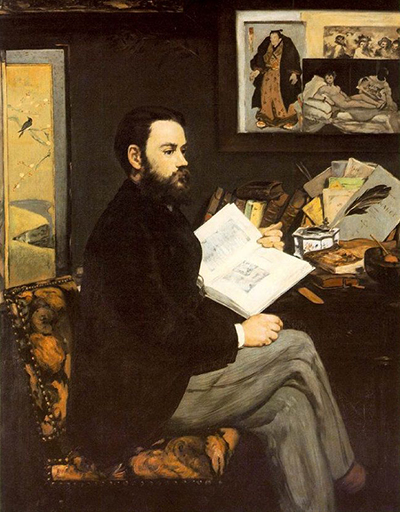Manet painted this particular painting of Emile Zola in 1868. Zola was a respected 19th-century novelist and art critic. Not just any art critic though, but a champion for the underdog.
He took a specific interest in painters who got little respect from the traditional art critics, one of them Edouard Manet. According to Zola, Manet's works belonged in the Louvre and to get the point across Zola wrote a lengthy article about the artist in 1866 and organized a private exhibition. As a thank you gesture, Manet offered to paint Zola’s portrait.
On the wall, we see Manet's Olympia a painting the critics regarded as vulgar at the time and caused a scandal in Paris at the 1865 Salon. The reason it is pictured along with Emile Zola is that Zola regarded it Manet’s finest work. Above the painting of ‘Olympia’ we see a copy of ‘The Triumph of Bacchus’ painted in 1628 by Velazquez's Bacchus, a Spanish painter both Manet and Zola admired. Both Manet and Zola also favored Japanese art as shown by the presence of a Japanese painting of a wrestler in traditional garb, by Utagawa Kuniaki II, and a decorative partition.
It should be noted that while the Japanese wrestler, Olympia and the characters in ‘The Triumph of Bacchus’ are all looking at Emile Zola, Zola himself has turned away from them. Zola is portrayed seated at a desk, piled high with books and papers, a quill and an inkwell, hinting at Zola’s profession. Zola himself is holding a book on his lap, possibly ‘L’Histoire des peintres’, no doubt one of Manet’s favorite go to books. In the January 1975 issue of the Burlington magazine, Professor Theodore Reff wrote that the objects pictured in ‘Emile Zola’s portrait’ were more important to Manet than to Zola himself.
It is believed that Zola was not thrilled with the painting Manet gave him and gave it a place in the entrance of his home rather than the living room or his work room. Remembering the sitting it was noted that Zola said “Now and again, half-dozing off as I sat there, I looked at the artist standing at his easel, his features taut, his eyes bright, absorbed in his work. He had forgotten me; he no longer realized that I was there.” Portrait of Emile Zola is an oil on canvas, measuring 57.48 x 44.88 inches. Edouard Manet was born in Paris, France, on January 23, 1832, and died on April 30, 1883, at the age of 51. During his lifetime, he painted 430 works ranging from people to landscapes, flowers and still lives.




